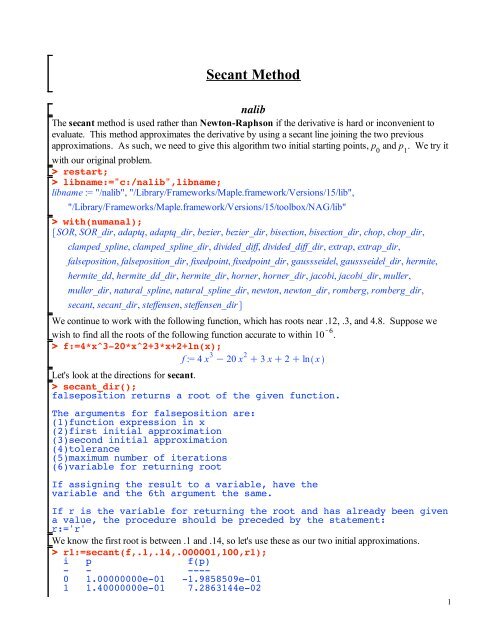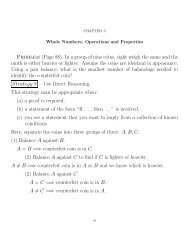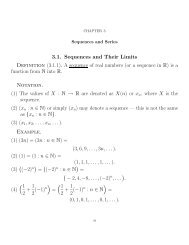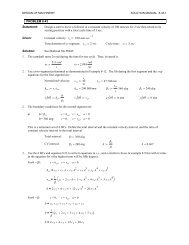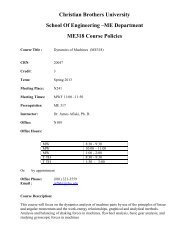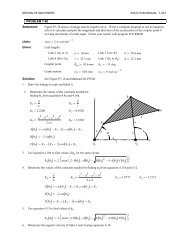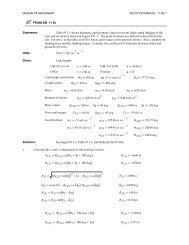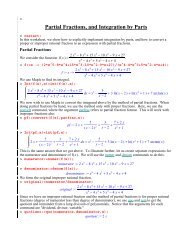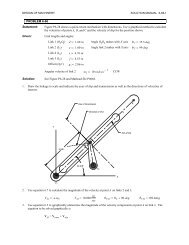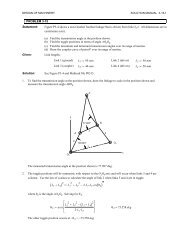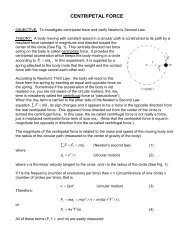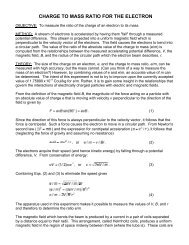Secant Method - CBU
Secant Method - CBU
Secant Method - CBU
Create successful ePaper yourself
Turn your PDF publications into a flip-book with our unique Google optimized e-Paper software.
2 1.29263051e-01 1.6344024e-023 1.26158174e-01 -2.0303100e-034 1.26501254e-01 4.6737000e-055 1.26493534e-01 1.2800000e-076 1.26493513e-01 1.0000000e-09The approximate solution is r1 = 0.12649351with f(r1) = 0.00000000r1 := 0.1264935127We see that secant takes more steps than newton, but the tradeoff is that the derivative does not need tobe computed at each step. Now let's go for the second root and take .2 and .23 as initial approximations.> r2:=secant(f,.23,.2,.000001,100,r2);i p f(p)- - ----0 2.30000000e-01 2.1099203e-011 2.00000000e-01 2.2256209e-012 7.77081173e-01 -6.1210921e+003 2.20246436e-01 2.2029655e-014 2.39590586e-01 1.9688857e-015 4.02297585e-01 -6.8010064e-016 2.76119141e-01 1.0080624e-017 2.92407351e-01 3.7579184e-028 3.02088295e-01 -5.6467170e-039 3.00823647e-01 2.3451600e-0410 3.00874075e-01 1.3400000e-0611 3.00874365e-01 1.0000000e-09The approximate solution is r2 = 0.30087436with f(r2) = 0.00000000r2 := 0.3008743650Notice that our initial approximations did not bracket the root. Neither did some other pairs of successiveapproximations, such as the third and fourth. Also notice that the initial approximations can be enteredout of order. Now let's find the third root, and bracket the root with initial approximations of 4 and 5.> r3:=secant(f,4,5,.000001,100,r3);i p f(p)- - ----0 4.00000000e+00 -4.8613706e+011 5.00000000e+00 1.8609438e+012 4.72316918e+00 -6.9805422e+003 4.79868425e+00 -5.7869447e-014 4.80551043e+00 2.0958366e-025 4.80527185e+00 -5.9232000e-056 4.80527252e+00 -2.7300000e-07The approximate solution is r3 = 4.80527252with f(r3) = -0.00000027r3 := 4.805272523NumericalAnalysisThere is a procedure called <strong>Secant</strong> in the NumericalAnalysis subpackage of the Student package. Weuse it to find the third root above.> with(Student[NumericalAnalysis]);AbsoluteError, AdamsBashforth, AdamsBashforthMoulton, AdamsMoulton, AdaptiveQuadrature,AddPoint, ApproximateExactUpperBound, ApproximateValue, BackSubstitution, BasisFunctions,Bisection, CubicSpline, DataPoints, Distance, DividedDifferenceTable, Draw, Euler, EulerTutor,2
ExactValue, FalsePosition, FixedPointIteration, ForwardSubstitution, Function,InitialValueProblem, InitialValueProblemTutor, Interpolant, InterpolantRemainderTerm,IsConvergent, IsMatrixShape, IterativeApproximate, IterativeFormula, IterativeFormulaTutor,LeadingPrincipalSubmatrix, LinearSolve, LinearSystem, MatrixConvergence,MatrixDecomposition, MatrixDecompositionTutor, ModifiedNewton, NevilleTable, Newton,NumberOfSignificantDigits, PolynomialInterpolation, Quadrature, RateOfConvergence,RelativeError, RemainderTerm, Roots, RungeKutta, <strong>Secant</strong>, SpectralRadius, Steffensen, Taylor,TaylorPolynomial, UpperBoundOfRemainderTerm, VectorLimit<strong>Secant</strong>(f,x=[4,5],stoppingcriterion=absolute,tolerance=10^(-6),output=information,maxiterations=100);n p nabsolute error0 4. -1 5. -2 4.723169181 0.2768308193 4.798684254 0.0755150734 4.805510432 0.0068261785 4.805271851 0.0002385816 4.805272523 6.72 10 -7<strong>Secant</strong>(f,x=[4,5],stoppingcriterion=absolute,tolerance=10^(-6),output=plot,maxiterations=100);3
5 iteration(s) of the secant method applied tof x = 4 x 3 K 20 x 2 C 3 x C 2 C ln xwith initial points a = 4. and b = 5.axp 5bfx4


